For many gardeners, the gardening season is over at the end of autumn. This is a great time to clear your garden of dead plants, do some deadheading, cut back spent flowers and prepare the soil for next spring. However, there is a wide range of flowers that bloom even during wintertime. Some of these plants bloom while there is still snow on the ground.
Mild climates are particularly suitable for growing winter gardens. Growing plants during winter may seem challenging at first, but we have some tips that will help you succeed on the first try. Once you start to see results, you will surely want to add life and colour to your garden every winter.
In the following article, you will find valuable tips for growing a winter garden. We have also put together a list of our favorite winter flowering plants.
Tips for Growing a Winter Garden
The most important thing that you must know when you decide to start a winter garden, is that you don’t have a lot to lose if you fail. There is little risk of killing your plants since most plants have a natural ability to adjust to weather changes.
When it comes to perennials, if your plants are not suitable for your winter garden, they will most likely enter a dormant stage. Once they finish their dormant stage, they come back to life the next season. With that in mind, here are a few tips that can make a difference:
Check the USDA zones of each plant
Areas with mild climates are suitable for a wider range of winter flowering plants. Nonetheless, you should check the USDA zone for each plant, to make sure that it is suitable for your winter garden.
Protect buds and blooms during hard freezes
Many plants are capable of surviving colder nights yet a hard freeze can damage the buds of some plants like camellias or cherry trees. If your winter garden has plants that are about to bloom, check the weather regularly. In case of frost predictions, make sure to cover your sensitive plants with plastic sheets or commercial frost covers. The protective cover is not necessary if the freeze happens before the buds are set.
When to plant and how to care for the soil
You can continue to plant during the entire cold season, as long as the soil is soft enough to allow you to dig a hole. To keep root temperatures stable, add a good amount of mulch. A three-inch layer of compost will also be greatly appreciated by your winter plants.
When to water your outdoor plants in winter?
You should decrease watering during wintertime, yet keep an eye out for frost. If you get news of upcoming frost water your plants in advance to help them get through this challenging period. Hydrate not only the roots but also the above-ground shoots. This will allow your plants to get the necessary amount of water before the ground freezes.
How to deal with container plants during the cold months?
Houseplants should be brought indoors as they are not capable of surviving outdoors in winter. As far as the rest of the container plants go, even if they are hardier than apartment plants, they still need some protection. If possible, place them under eaves and cover them with frost cloths.
Best Plants for Your Winter Garden
1. Pansies and Violas
The Viola is the main genus that includes pansies. What makes pansies different from the rest of the violas is that they have one petal pointing downward and four petals pointing upward. Violas have two pointing upward and three pointing downward. Both pansies and violas can bloom even in wintertime in mild climates. Even though they are annuals, they self-seed so you might find more of them in your garden next spring. Depending on the climate, some pansies might even survive winter and give you a second blooming session in early spring.
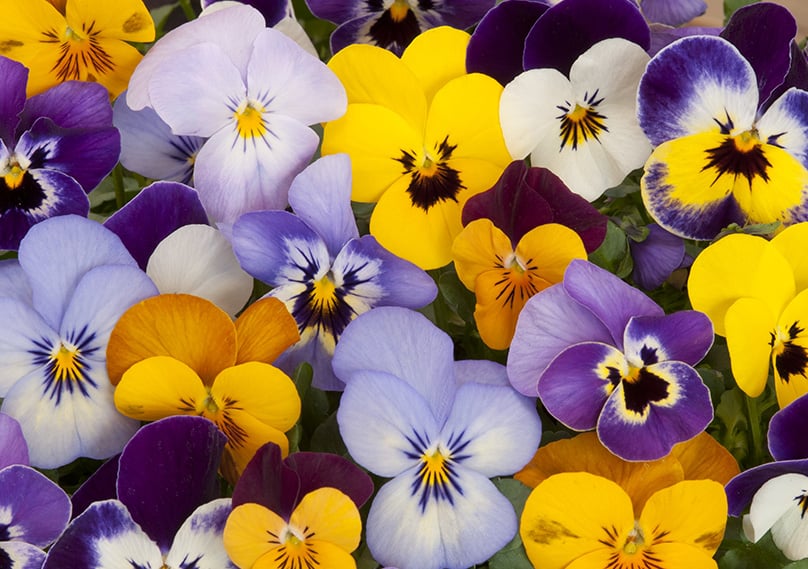
For pansies and violas to bloom in winter, plant them at the end of October, or even in November if the weather allows it. Pansies and violas look good when planted in a large mass. As such, plant as many as your space allows for a powerful visual impact. Add compost to enrich the soil and water the plants regularly, especially if you are experiencing a dry winter.
2. Primrose
If you are looking for a perennial that blooms for most of the year, primrose is one of the best choices. This plant is highly appreciated by gardeners for the bright colors of its flowers. Primrose can also be used as an indoor plant, and it looks amazing outdoors in flower beds, in rock gardens, or in even in garden boxes. Primrose flowers and leaves are also edible. The flowers can be consumed raw, and the leaves can be consumed either raw or cooked.

You should plant Primrose in partial shade, in a well-drained soil enriched with organic matter. In colder climates, it will behave as an annual. Nonetheless, whether it behaves as an annual or a perennial, its blooms will beautify your garden in the cold months of January and February. Since winter plants don’t grow as much as warm-season plants, you can space Primroses closer together.
3. Bellis
Bellis plants are hardy perennials, perfect for fall and winter gardens. They reach a top height of 20 cm, and you can easily mow them over once the flowering season ends. They are appreciated for their lovely solitary lowers in shades of red, pink, and white. Bellis daisies are the most famous Bellis plants.
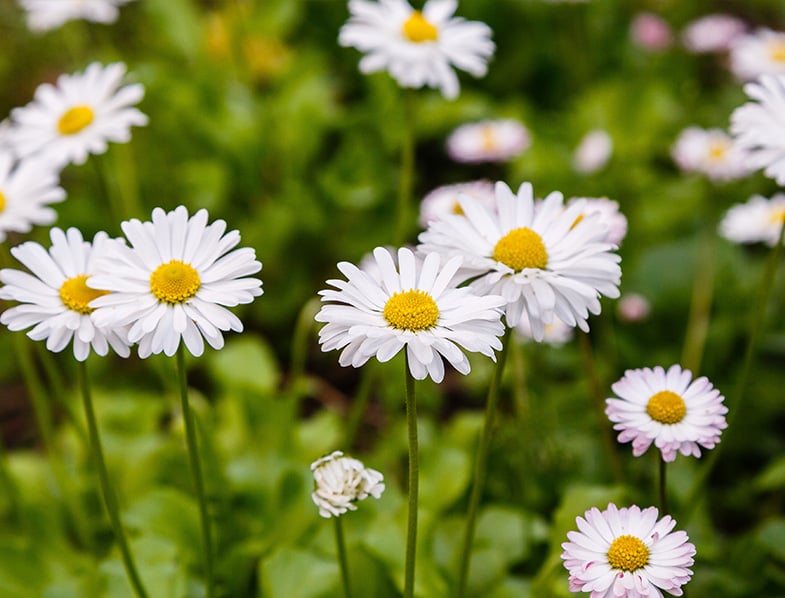
Whether you want to enjoy their blooms in spring or winter, you should plant Bellis in a place where they can get plenty of natural sunlight. Caring for these perennials in winter is quite easy. They need little watering, but they do like the soil to be kept relatively moist. Compost and mulch will help with that. It is important to water only the soil as watering the leaves can cause frostbites. Because Bellis plants grow very slowly in the winter, you can help them with a little fertilizer. Choose a diluted liquid fertilizer and only feed the plants once every 40 days.
4. Winter Jasmine
If you want to add some versatility to your winter garden, combine your low-growing perennials with a medium-sized shrub. Winter jasmine’s bright yellow flowers will liven up even the most boring winter landscape. This shrub can reach a top height of three meters and a top spread of two meters. It blooms in mid-winter or early spring. It is described as a climbing plant, but it needs good support to properly climb. However, it does a great job tumbling down arches, bridges, or walls.
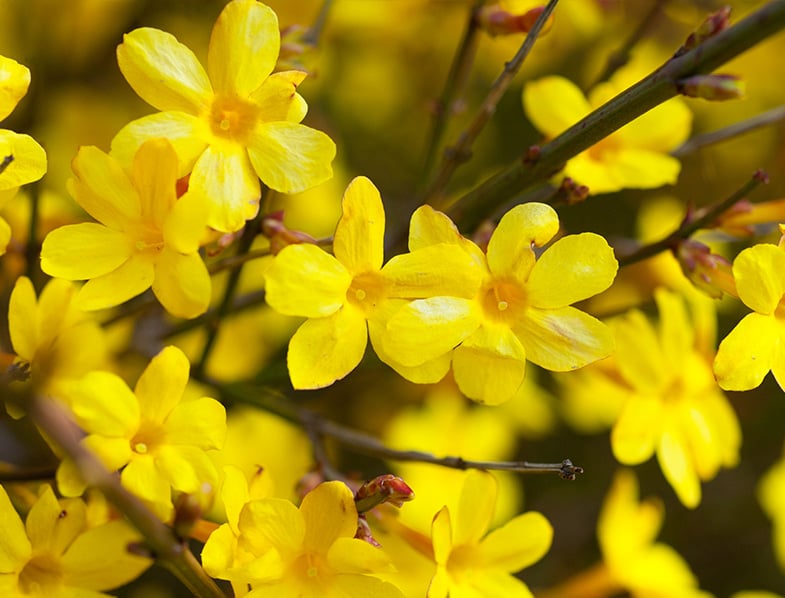
This is not a very demanding plant. It has sparse leaves, and it needs minimum pruning. To improve the poor aspect of its leaves and to make it look better, plant your Winter Jasmine next to an evergreen shrub. The stems tend to get a bit tangled, which is why it looks better when pruned. Pruning should only be done after flowering, as this plant blooms on last year’s wood. If it outgrows its space, it can be cut back to 60 cm. However, cutting back might mean that it won’t bloom until it grows back to a full size.
5. Hellebores
Also known as Winter Roses, these hardy perennials bloom from late winter to spring. They will even bloom in the snow. Their height ranges from 30 cm to one meter, and they can reach a top spread of one meter. They have green, white, plum, yellow, or pink flowers and their leaves are mostly evergreen. They look great in massed plantings and they can make for great ground covers.
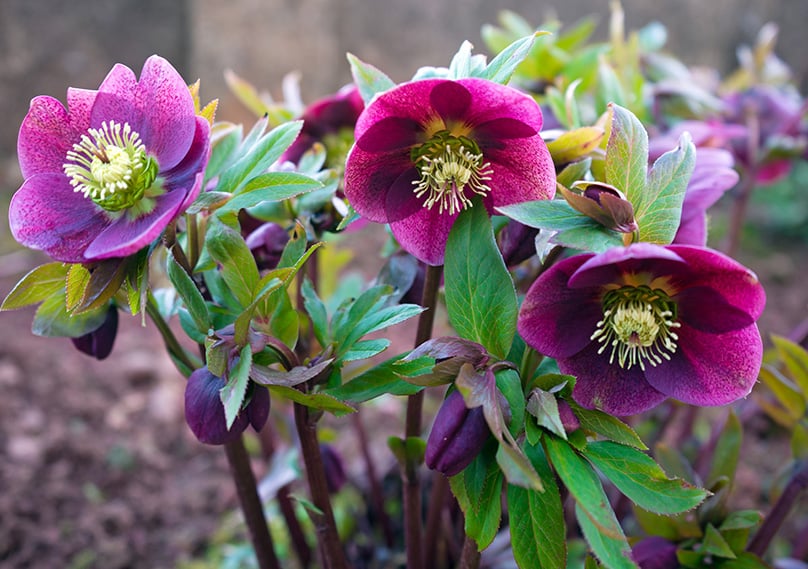
Generally, they are shade-loving plants, but in winter they grow better in a sunny location. They thrive in fertile, hummus-rich soil. They prefer neutral or alkaline soil, so add some lime if your soil is too acidic. They need regular watering when they are young. Once they mature, they are drought-resistant and they don’t have any problems with frost. As far as maintenance goes, prune back spent foliage in spring and feed them some granular balanced fertilizer. Add some much in the fall to keep soil temperature and humidity under control in winter. To learn more, read our Hellebore Guide.
6. Pieris
Also known as the Lily Of The Valley Bush, this evergreen perennial will beautify your garden with splendid flowers. It blooms from late January until late spring. It can reach a top height of 3 meters and a top spread of 2,5 meters. Not only are its delicate white or pink flowers a delight for your eyes, but Pieris will also enchant you with its strong, refreshing fragrance.
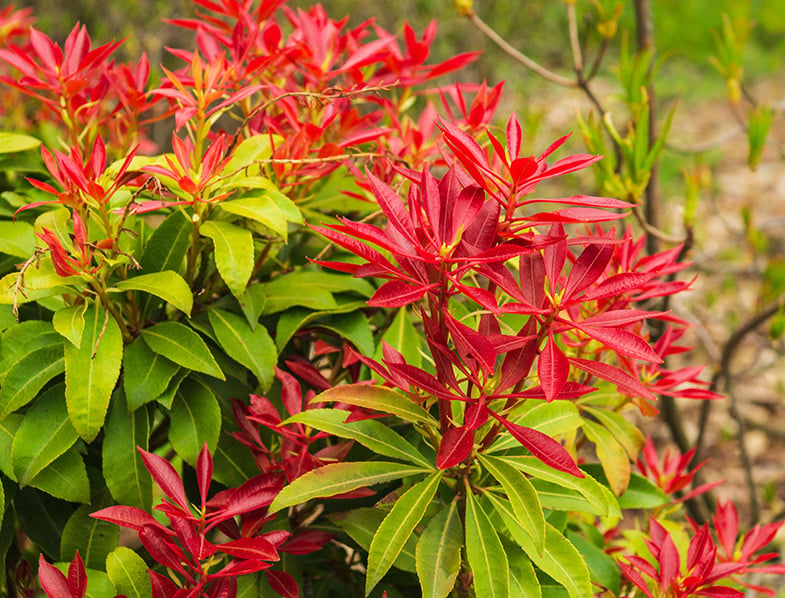
Pieris can tolerate partial shade, but it will perform better in winter if it is planted in a full sun location. It prefers moist, well-drained soil and an acidic pH. It will benefit from soil that’s enriched with organic matter. While Pieris can withstand lower temperatures, it does need some type of shelter when it comes to heavy rains and extreme winds. It needs to be watered regularly, but the watering frequency depends on the climate. As a general rule, the soil should be moist down to 7 cm.
7. Winterberry
Even though the winterberry drops its leaves in the winter, it maintains its deep red berries, throughout winter. The berries make a lovely contrast with the snow. This shrub can reach a top height of four meters with a similar spread. It can adapt to most garden conditions and it looks best in massed plantings. Space the bushes about one meter apart for the best visual impact.
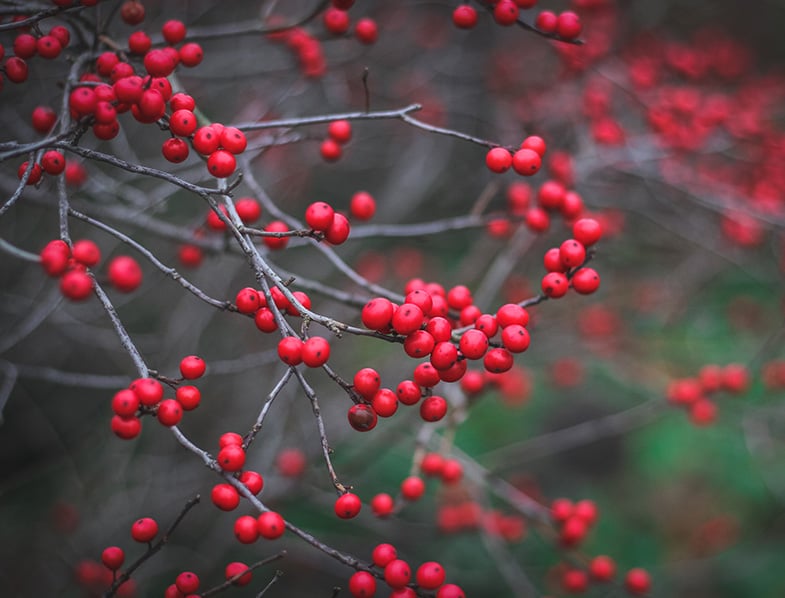
The Winterberry bush thrives in partial shade and full sun. As far as the soil is concerned, it prefers moist, acidic soil. Compost or peat moss will help you keep the soil moist. You can grow this plant from cuttings or nursery transplants. It is a dioecious plant so the male and female flowers form on different plants. To encourage berry production, place at least one male plant for every 4 female plants. It doesn’t need fertilizer unless unfavourable conditions cause very slow growth.
8. Winter Aconite
There is nothing more precious than tiny blooms that boldly pop through the snow. This is one of the reasons why we love winter aconites. These buttercup yellow blooms look best when they are planted in masses. They have a top height of 15 cm. Winter aconite has a single flower per stem, and the leaves grow circular around the stem, creating a sort of a green skirt under the flower head. The flowers only last a few days, but the leaves persist for a very long time, so they make a great ground cover.

Winter aconite is one of the plants that need the least maintenance. It is very hardy, disease-free, and pest-free. Moreover, it almost thrives on neglect. It can tolerate different types of light conditions, from full sun to light shade. Sunny locations will encourage more vigorous growth. This plant grows best in alkaline soil, but it can tolerate different types of soils. It doesn’t need regular watering unless the soil gets extremely dry. It also doesn’t need any fertilizer. It can be propagated through division, but it is an excellent self-seeder so it will quickly spread wherever it is allowed. Learn more about this versatile plant from our Winter Aconite Guide.
In Conclusion
These are but our top winter flowering plants, but many other plants bloom in winter. We chose these particular plants because they are versatile and hardy. We tried to include different plant sizes and various bloom colours. We also included plants with different growing requirements to suit the needs of any garden.
Choosing the right plants depends not only on your preference for flowers. It also depends on your garden design, the sun layout of your space, your soil type, and much more. If you want to experiment with other flowers, make sure to read their USDA zones and their requirements.
Don’t be disappointed if things don’t turn out as expected on the first try. Keep in mind that designing your garden is a continuous process. It requires experiments and constant changes in your gardening practices.
